By D. Fisher — 1900
Back to previous section — Forward to next section — Return to Table of Contents
CHAPTER 11
Great Boar’s Head
Great Boar’s Head is one of the most conspicuous objects, as seen from the ocean, between Boston and the Isles of Shoals. It is a true lenticular moraine or mound of glacial drift called till, some 1,300 feet long, of pyramidal shape, about 50 feet high, thrust out into the ocean from the coast line. At one time, it was probably of very much greater area. It is the opinion of geologists that this mass of till was deposited under the great ice cap which once covered Northern America. An examination shows that there are two strata in this moraine known as the upper and lower till, in which are boulders of all sizes. Of the rocks strewn around the base the most abundant are what is known as Exeter sienite. They undoubtedly came from between Dover and Exeter. The nearest source of others is the Gilford hills some seventy-seven miles away. Some small boulders of limestone came from near Machias, Me. 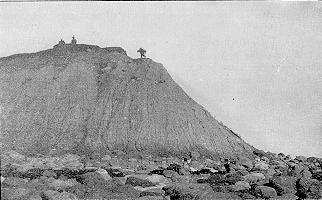
Great Boar’s Head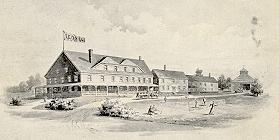
The Leonia Hotel along High St.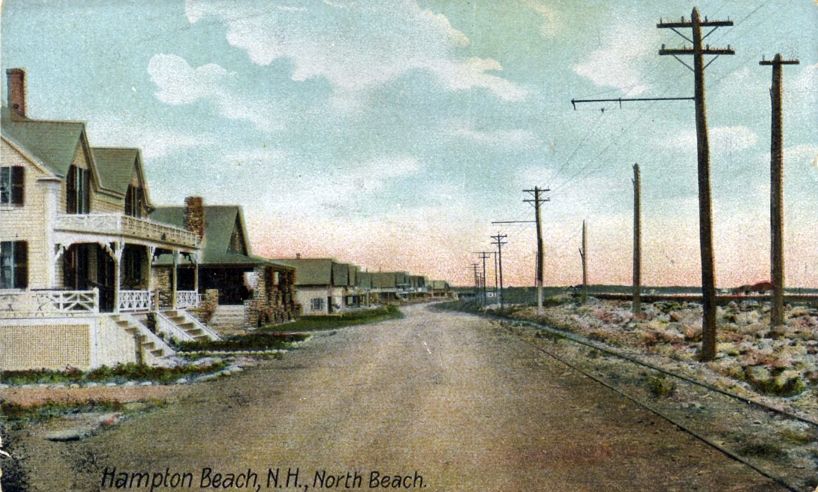
Looking Up North Beach from Boar’s HeadThe first public house, on any part of the beach south of the causeway, was opened in 1820. It was nearly on the site of the present Hampton Beach hotel. In 1827, it came into the possession of Thomas Leavitt, Esq., who enlarged it. It was burned in 1854. The present new and commodious house was opened in 1872. 
Hampton Beach Hotel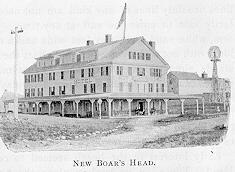
New Boar’s Head Hotel
Leavitt’s at North Beach
A hotel was built on the Head in 1826. It was enlarged in 1841, and was destroyed by fire. Nudd’s hotel was first opened in 1830. The land on the Head was owned by David Nudd, whose heirs sold it to Colonel S. H. Dumas, who now owns these most desirable hotel sites. The Sea View House (Cutler’s), south of the Head, was opened in 1885.
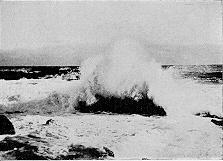
Surf on the RocksHampton beach is divided by Great Boar’s Head into two parts. North beach may be said to extend from the Head some two miles to Little Boar’s Head in North Hampton. Most of the bathing on this beach is done near the new “Life Saving Station,” about a mile from the Head. South beach is nearly as long, and reaches from the Head to Hampton river. Both north and south the shore swings back in a sharp curve from the point of the Head. Both of these curved lines are strewn with boulders which have been washed from the Head during the many hundreds of years that it has been slowly wearing away, and prevent bathing in the vicinity of promontory. From near the Sea View House south to Sandy Point at the mouth of Hampton river, a distance of nearly a mile and a half, is a beach of which it can be said that there is no finer or safer beach for the bather on the whole coast.From high water mark far out, the slope of the bottom is so gentle that it seems almost level. For this reason, and at any state of the tide, there is almost no undertow. Life lines or safety lines of any kind are not needed. It is perfectly safe to enter the surf at any time. This stretch of firm, white sand, over 500 feet wide and a mile and a half long, with not a shell or a pebble to hurt the tenderest feet, stands almost alone in its class. Here may now be seen parties of cyclers, games of croquet, lads playing ball, young men and women playing at bowls, groups of bathers, and family parties sitting and lying on the warm sand all through the day. Nor will there be anything seen or heard to offend the most fastidious of visitors. 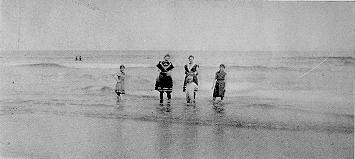
Surf bathing at Hampton Beach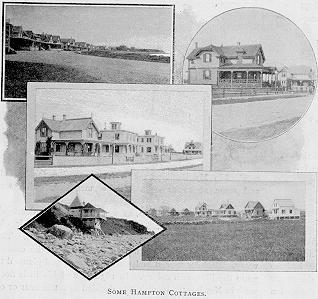 Early interest in the beach seemed to center about the Head. There, on its western slope, the hotels and early cottages were erected in just the one place where visitors were shut off from a direct view of the ocean, and at the least pleasant place for bathing. Boarders for the season came to lounge and rest on the Head. Only in recent years did cottages begin to appear on the upper part of South beach. Then the beach was, in a sense, only locally known. An old resident has just written of it that “the arrival of two coach loads of visitors was quite an event..” It is of this unique and beautiful South beach that Whittier, in his “Wreck of the Rivermouth,” sang:“And fair are the sunny isles in view,
Early interest in the beach seemed to center about the Head. There, on its western slope, the hotels and early cottages were erected in just the one place where visitors were shut off from a direct view of the ocean, and at the least pleasant place for bathing. Boarders for the season came to lounge and rest on the Head. Only in recent years did cottages begin to appear on the upper part of South beach. Then the beach was, in a sense, only locally known. An old resident has just written of it that “the arrival of two coach loads of visitors was quite an event..” It is of this unique and beautiful South beach that Whittier, in his “Wreck of the Rivermouth,” sang:“And fair are the sunny isles in view,
East of the grisly Head of the Boar.
And Agamenticus lifts its blue
Disk of a cloud the woodlands o’er.
“And southerly, when the tide is down,
‘Twixt white sea waves and sand hills brown
The sea birds dance, and the gray gulls wheel,
Over a floor of burnished steel.”
And from his “Hampton Beach” comes,
“Ha! like a kind hand on my brow,
Comes this fresh breeze,
Cooling its dull and feverish glow,
While through my being seems to flow
The breath of a new life, the healing of the seas.
* * * * * * * * * * * * * * * * * * * * * * * * * * *
“Good-by to pain and care! I take
Mine ease to-day;
Here where these sunny waters break,
And ripples this keen breeze, I shake
All burdens from the heart,
All weary thoughts away.”
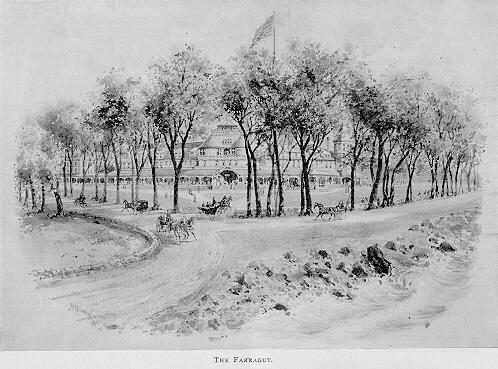
Farragut Hotel in RyeBack to previous section — Forward to next section — Return to Table of Contents








 Early interest in the beach seemed to center about the Head. There, on its western slope, the hotels and early cottages were erected in just the one place where visitors were shut off from a direct view of the ocean, and at the least pleasant place for bathing. Boarders for the season came to lounge and rest on the Head. Only in recent years did cottages begin to appear on the upper part of South beach. Then the beach was, in a sense, only locally known. An old resident has just written of it that “the arrival of two coach loads of visitors was quite an event..” It is of this unique and beautiful South beach that Whittier, in his “Wreck of the Rivermouth,” sang:
Early interest in the beach seemed to center about the Head. There, on its western slope, the hotels and early cottages were erected in just the one place where visitors were shut off from a direct view of the ocean, and at the least pleasant place for bathing. Boarders for the season came to lounge and rest on the Head. Only in recent years did cottages begin to appear on the upper part of South beach. Then the beach was, in a sense, only locally known. An old resident has just written of it that “the arrival of two coach loads of visitors was quite an event..” It is of this unique and beautiful South beach that Whittier, in his “Wreck of the Rivermouth,” sang: